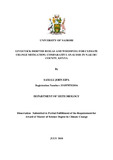Livestock derived biogas and woodfuel for climate change mitigation: comparative analysis in Nakuru county, Kenya

View/
Date
2018-07Author
Samali, John Eipa
Type
ThesisLanguage
enMetadata
Show full item recordAbstract
Increasing greenhouse gases levels and consequently climate change is one of the serious concerns of developing and developed countries. The main greenhouse gases in the earth‟s atmosphere are Carbon dioxide (CO2), Methane (CH4) and Nitrous oxide (N2O). In Nakuru County about 50.5% of people utilize woodfuel as a source of energy and there are lots of unmanaged livestock manure which both release methane emissions that contribute to climate change. This study contributes towards reducing methane emissions through the use of biogas as strategy for climate change mitigation in Nakuru County; Kenya. The specific objectives of the study were to determine the quantity of woodfuel and biogas used by wood stove and biogas stove user households, to estimate reduced quantity of woodfuel usage and methane emissions from use of biogas in mitigating climate change, and to examine how use of biogas contributes to improvement of household livelihoods.
Multi-stage sampling technique was used to come up with a sample for the cross sectional survey; dairy cattle farmers‟ households were clustered and purposively sampled. The instruments for survey were questionnaires and interviews. Collected data were coded and analyzed using quantitative and qualitative techniques. Content analysis, descriptive statistics and inferential statistics were also used summarize data and determine significance level.
Mature trees felled for woodfuel by wood stove and biogas stove user households were 14 and 7 per HH per year respectively. The annual demand of woodfuel from forests exceeded the supply by 0.02% per HH per year, translating to felling of 10.5 mature trees instead of 10.3 mature trees per HH per year. This implied that woodfuel use is unsustainable. The use of biogas resulted in reduction of woodfuel usage by 3899.4 Kg/HH/year. This reduction saved 53.3-54.1% of methane emissions annually from being emitted to the global atmosphere. Conserved trees in the forests from reduced woodfuel usage increased carbon sink for Carbon dioxide by 72.6% annually. There was a saving of Ksh.3599.00 per planting season from not buying mineral fertilizers for each biogas user household. Use of bio-fertilizer avoided nitrous oxide emissions from nitrogenous fertilizers.
Publisher
University of Nairobi
